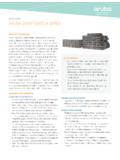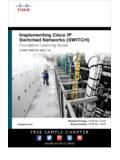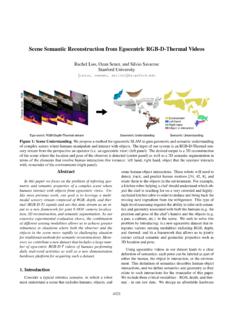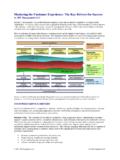Transcription of 1 SegNet: A Deep Convolutional Encoder-Decoder ...
1 1 SegNet: A deep ConvolutionalEncoder- decoder architecture for ImageSegmentationVijay Badrinarayanan, Alex Kendall, Roberto Cipolla,Senior Member, IEEE,Abstract We present a novel and practical deep fully Convolutional neural network architecture for semantic pixel-wise segmentationtermed SegNet. This core trainable segmentation engine consists of an encoder network, a corresponding decoder network followedby a pixel-wise classification layer. The architecture of the encoder network is topologically identical to the 13 Convolutional layers in theVGG16 network [1].
2 The role of the decoder network is to map the low resolution encoder feature maps to full input resolution featuremaps for pixel-wise classification. The novelty of SegNet lies is in the manner in which the decoder upsamples its lower resolution inputfeature map(s). Specifically, the decoder uses pooling indices computed in the max-pooling step of the corresponding encoder toperform non-linear upsampling. This eliminates the need for learning to upsample. The upsampled maps are sparse and are thenconvolved with trainable filters to produce dense feature maps.
3 We compare our proposed architecture with the widely adopted FCN [2]and also with the well known DeepLab-LargeFOV [3], DeconvNet [4] architectures. This comparison reveals the memory versusaccuracy trade-off involved in achieving good segmentation was primarily motivated by scene understanding applications. Hence, it is designed to be efficient both in terms of memory andcomputational time during inference. It is also significantly smaller in the number of trainable parameters than other competingarchitectures and can be trained end-to-end using stochastic gradient descent.
4 We also performed a controlled benchmark of SegNetand other architectures on both road scenes and SUN RGB-D indoor scene segmentation tasks. These quantitative assessmentsshow that SegNet provides good performance with competitive inference time and most efficient inference memory-wise as comparedto other architectures. We also provide a Caffe implementation of SegNet and a web demo at Terms deep Convolutional Neural Networks, Semantic Pixel-Wise segmentation , Indoor Scenes, Road Scenes, encoder , decoder , Pooling, INTRODUCTIONS emantic segmentation has a wide array of applications rangingfrom scene understanding, inferring support-relationships amongobjects to autonomous driving.
5 Early methods that relied on low-level vision cues have fast been superseded by popular machinelearning algorithms. In particular, deep learning has seen huge suc-cess lately in handwritten digit recognition, speech, categorisingwhole images and detecting objects in images [5], [6]. Now thereis an active interest for semantic pixel-wise labelling [7] [8], [9],[2], [4], [10], [11], [12], [13], [3], [14], [15], [16]. However, someof these recent approaches have tried to directly adopt deep archi-tectures designed for category prediction to pixel-wise labelling[7].
6 The results, although very encouraging, appear coarse [3].This is primarily because max pooling and sub-sampling reducefeature map resolution. Our motivation to design SegNet arisesfrom this need to map low resolution features to input resolutionfor pixel-wise classification. This mapping must produce featureswhich are useful for accurate boundary architecture , SegNet, is designed to be an efficient ar-chitecture for pixel-wise semantic segmentation . It is primarilymotivated by road scene understanding applications which requirethe ability to model appearance (road, building), shape (cars, V.)
7 Badrinarayanan, A. Kendall, R. Cipolla are with the Machine Intelli-gence Lab, Department of Engineering, University of Cambridge, : and understand the spatial-relationship (context) be-tween different classes such as road and side-walk. In typical roadscenes, the majority of the pixels belong to large classes suchas road, building and hence the network must produce smoothsegmentations. The engine must also have the ability to delineateobjects based on their shape despite their small size.
8 Hence it isimportant to retain boundary information in the extracted imagerepresentation. From a computational perspective, it is necessaryfor the network to be efficient in terms of both memory andcomputation time during inference. The ability to train end-to-endin order to jointly optimise all the weights in the network usingan efficient weight update technique such as stochastic gradientdescent (SGD) [17] is an additional benefit since it is more easilyrepeatable. The design of SegNet arose from a need to match encoder network in SegNet is topologically identical tothe Convolutional layers in VGG16 [1].
9 We remove the fullyconnected layers of VGG16 which makes the SegNet encodernetwork significantly smaller and easier to train than many otherrecent architectures [2], [4], [11], [18]. The key component ofSegNet is the decoder network which consists of a hierarchyof decoders one corresponding to each encoder . Of these, theappropriate decoders use the max-pooling indices received fromthe corresponding encoder to perform non-linear upsampling oftheir input feature maps.
10 This idea was inspired from an archi-tecture designed for unsupervised feature learning [19]. Reusingmax-pooling indices in the decoding process has several [ ] 10 Oct 20162 Fig. 1. SegNet predictions on road scenes and indoor scenes. To try our system yourself, please see our online web demo at ; (i) it improves boundary delineation , (ii) it reduces thenumber of parameters enabling end-to-end training, and (iii) thisform of upsampling can be incorporated into any encoder -decoderarchitecture such as [2], [10] with only a little of the main contributions of this paper is our analysisof the SegNet decoding technique and the widely used FullyConvolutional Network (FCN) [2].
![arXiv:0706.3639v1 [cs.AI] 25 Jun 2007](/cache/preview/4/1/3/9/3/1/4/b/thumb-4139314b93ef86b7b4c2d05ebcc88e46.jpg)

![arXiv:1301.3781v3 [cs.CL] 7 Sep 2013](/cache/preview/4/d/5/0/4/3/4/0/thumb-4d504340120163c0bdf3f4678d8d217f.jpg)
![@google.com arXiv:1609.03499v2 [cs.SD] 19 Sep 2016](/cache/preview/c/3/4/9/4/6/9/b/thumb-c349469b499107d21e221f2ac908f8b2.jpg)











